Eddie Van Halen Shares the Guitars Behind His Quest for Tone
Ed explains the roles that various guitars in his collection have played in his quest to find the ultimate tone.

This is an excerpt from the January/February 2014 issue of Guitar Aficionado magazine.
Most guitarists and fans who have paid close attention to Eddie Van Halen’s career likely think of him as a “serial monogamist” when it comes to the guitars he plays. During the early days of Van Halen, he was known for playing his Frankenstein guitar that he assembled from various parts, and during the Eighties he was usually spotted onstage with his trademark Kramer 5150 guitar.
After that, Ed went through a succession of signature-model guitars that he designed that were built by Music Man and Peavey. Those guitars led to the ultimate solution – establishing his own EVH brand, which produces various guitars, 5150 amplifiers, cables, accessories and other products entirely to Ed’s own specifications, including the Wolfgang model guitars that are his main workhorse instruments today.
However, over the years Ed has amassed quite an impressive and deep collection of many other guitars that have played important, behind-the-scenes roles in Van Halen’s music. Some of these guitars inspired new songs, while others made cameo appearances during solos or overdubs recorded in the studio.
Then there are several gifts given to Ed, particularly the various guitars that his mentor Les Paul gave to him over the years. And like anyone who has played guitar for a while, Ed has made a handful of impulse purchases, picking up instruments that catch his eye if only for their aesthetic appeal.
The storage space at 5150 studios, where Van Halen keeps his gear, makes Guitar Center’s Hollywood flagship location look like a humble mom and pop store. Boxes marked with the EVH brand logo are stacked neatly near the entrance, and row upon row of old, battered guitar cases line the walls, concealing their mysterious and alluring contents.
As Matt Bruck, Van Halen’s business partner and our tour guide for the day, asks if there are any guitars we’d like to see, our minds are immediately flooded with recollections of rare or obscure guitars that Van Halen has mentioned in past interviews or that we caught fleeting glimpses of in old concert photos. Most of those instruments are still around, but even more fascinating are the guitars that we never knew Van Halen had.
“I’m not the typical guitar collector in the least,” Van Halen says as he goes through the stacks and pulls out a few of his personal favorites. “I’ve bought a lot of vintage pieces over the years, but I’ve destroyed quite a few of them. People might think, How could you desecrate the Mona Lisa? But I really don’t care what something looks like.
"I’m more concerned with a guitar’s functionality, sound and playability. That’s why I started building my own guitars. Other guitars wouldn’t do what I needed them to do, so I made my own.”
Van Halen is not exaggerating. As the photos on the following pages show, he has no qualms about performing rather drastic surgery on instruments to achieve the sound or performance he desires.
Vintage purists may want to look away, but the various scars, marks, and modifications that he’s made even on valuable vintage instruments tell the tale of a man who is constantly looking for ways to improve the tools of his trade and who refuses to accept the commonly held belief that all progress in electric guitar design stopped in 1959.
That attitude resulted in a treasure trove of innovations that Van Halen either invented or inspired, including the hybrid Super Strat design (with PAF humbuckers instead of single-coil pickups), customized high-gain amps, bold graphic finishes and other developments that most of today’s guitarists take for granted.
“There is always something new for me around the corner,” Van Halen says. “My tastes are always changing. I used a Wolfgang Stealth with an ebony fingerboard on our entire 2012 tour. Before that, my main guitars all had maple fingerboards, but one day I tried a guitar with an ebony board and thought that it felt pretty good.
"For the 2012–13 tour, I modified my 5150 III amp heads because my taste had changed again a little and I wanted to continue the evolution of the amp. We’re putting out the limited-edition 5150 III S with that mod, for anyone who wants what I am currently using. I just keep pushing to see what I can get out of something. Spinal Tap made a joke about things going to 11, but I’ve spent my whole life pushing things to 11.”
Even though Van Halen is constantly tinkering with his guitars, his love affair with the instrument is undeniable. During the interview, he pulls out a Sixties Teisco Del Rey with four pickups and wistfully explains how it is exactly the same as his very first guitar.
(“It’s ironic,” he says, “because my first guitar had four pickups and all these switches, but I’m known for having guitars with just one pickup and one volume knob.”) As he describes his first pro-quality guitar – a 1968 Gibson Les Paul Standard goldtop – the nostalgia and regret in his voice for a guitar that long got away from him is unmistakable.
“That was the first guitar I experimented with,” he says. “It originally had P-90 soapbar pickups, but I put a humbucker in the bridge. When we used to play at the Starwood and Whisky, people tripped at the sound I was getting from that guitar. They couldn’t see the humbucker in the bridge because my hand was covering it.
"That was just the first of many guitars that I fucked with. I took a PAF out of an ES-335 and the vibrato out of a Fifties Strat when I made my Frankenstein guitar, but it was worth it because it got me closer to the sound I was looking for. Out of all the experiments I’ve done, 87 percent of the time I was successful and 13 percent of the time I ruined it. But even after I ruined a guitar, I learned something.”
On the following pages, Ed explains the roles that various guitars in his collection have played in his quest to find the ultimate tone. Of course, he also discusses a few of his side excursions, but those examples have made his journey even more fascinating.
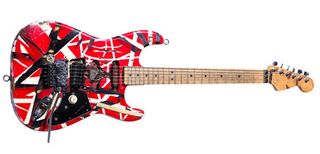
Frankenstein
“What trips me out about this guitar is that when I painted it red, that made it more famous. A lot of people still don’t know that it’s the same guitar as the black-and-white guitar on the cover of the first Van Halen album.
"That guitar went through a lot of different phases and changes. On the first record, it had a stock vintage Fender Strat vibrato, then the Floyd came around, and then I added the dummy pickup at the neck. I kept changing it because I was tired of people copying my guitar.”
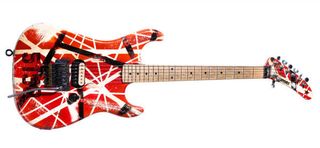
Kramer 5150
“It’s a workhorse. It served me for a very long time. When I retired my Frankenstein, that became my main guitar. I played it in a lot of videos – ‘Panama’ and ‘When It’s Love’ – and in the studio. I used that guitar up until I started using my Music Man EVH guitar. It still sounds great.”

1976 Ibanez Destroyer
“I used that a lot on the first album. I played it on every song that doesn’t have any vibrato-bar parts on it, like ‘You Really Got Me.’ I can’t remember what pickups were in it when I recorded the album – I was always changing them – but that was before I cut that big chunk out of it.
"When I first got the Destroyer, I painted it white. It was the same time that I painted my black-and-white guitar. After I finished painting that guitar, I figured that I might as well paint the Destroyer too.”
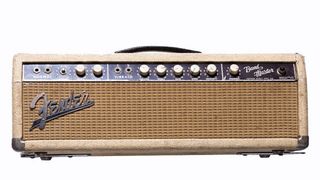
1963 Fender Bandmaster
“I used that amp for years in two ways. I already had the Marshall, but I had not stumbled onto the Variac thing yet, so I would use the Bandmaster through the Marshall cabinet when we gigged at smaller clubs like Gazzarri’s.
"In the little house in Pasadena that I grew up in, my mom always hated what she called ‘that high crying noise’ – in other words, soloing. She’d always go, ‘Why do you have to make that high crying noise?’
“If you plug the cabinet into the external speaker output instead of the regular output, it’s really quiet. I could turn everything all the way up, which is what I always did anyway, and there was this small amount of bleed that sounded exactly like when the regular output is turned all the way up, but it’s really quiet. Everyone says that you can’t do that because the transformer will blow, but the amp never blew up.
“The real beauty of that amp is how many songs I wrote with it. I wrote all of the early Van Halen songs for the first three albums with that amp, playing quietly in my room. It was really quiet, so my mom couldn’t hear me, but it sounded amazing.
"My dog Monty would sit down next to me, and he dug it. When I wrote the intro to ‘Women in Love,’ he was sitting there with his ears perked up, like the RCA Victor dog. That Bandmaster was more important than my Marshall head, because I wrote everything with it.”
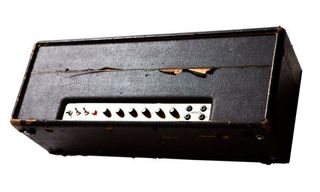
1968 Marshall Super Lead 100 Model 1959
“When I was working for a music store called Berry and Grassmuck in Pasadena, moving pianos and organs, a Marshall head came in one day that had belonged to the Rose Palace. The Rose Palace is a concrete building where they build Rose Parade floats. They used to have concerts there with bands like Iron Butterfly and Jimi Hendrix.
"When they stopped having concerts there, that Marshall ended up in the store. I had never seen a Marshall before, except in pictures. I told them that I didn’t care how long I had to work there, but I wanted that amp head."
“When I first plugged it in, I blew it up. When you’d plug it straight into the wall, it would go poof! When I got it fixed, it was too loud. I used to sit in my room and stare at it. I remember playing a gig with it once, and as I looked behind it I could see the glass bottles of the tubes melting! It was too hot.
"The Variac was the key to making that amp work. I always wondered, What will happen if I do this? That’s how I stumbled onto the Variac. I wondered if the amp would still work if I lowered the voltage. It worked for years. Sylvania 6CA7 tubes sound great in it, but the best set of tubes that I ever had in that amp was a matched set of Telefunkens.
“I eventually met someone who worked at the Rose Palace who told me it was the house amp. Probably everyone and their brother played through it. It remained stock throughout its life.”

Kramer Custom Double-Neck
“I used that live to play ‘Secrets’ off of Diver Down. On the record, I used a Gibson double-neck. I had that before the ‘Panama’ 5150 guitar, so it’s probably the first guitar I ever got from Kramer. Other than this guitar, no one at Kramer built any of my Kramer guitars. I built two of them myself. Every other Kramer that’s out there that's supposedly one of my guitars is a fake.
“The Baretta model that Kramer sold had nothing to do with me. I didn’t even know they were selling those things. In the early Eighties, everyone was copying me. I’d walk around the NAMM show and see all of these guitars with one pickup and one knob. The people at Schecter even called them Van Halen models. Every company on the planet was making one.”

Custom Steinberger/Gibson Les Paul
“I used that to record ‘Me Wise Magic.’ Ned Steinberger put the TransTrem on it. We were working together on the TransTrem design and he asked my opinion. I was trying to get him to make things simpler. He was such an engineer that he would over-engineer things.
"It was very kind of him to make a special guitar just for me. I used a regular Steinberger guitar on ‘Summer Nights,’ but it was hard to play. I ragged and moaned so much about it that he made me that guitar. It’s very fat sounding. Everything on that guitar is unique. The tuners are really different.”
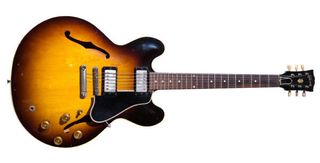
1958 Gibson ES-335
“I used that to record the ‘Big Fat Money’ guitar solo. [Producer] Bruce Fairbairn asked if I had any hollowbody guitars, so I asked Matt to grab me a 335. Bruce asked me to play something jazzy, so I did. When I was done, I asked him, ‘Something like that?’ He said, ‘That’s perfect. We’re done.’
"He had recorded it without telling me. That’s what you hear on the record. The guitar went back in the case, and I don’t think I’ve touched it since then.
“Sometimes I’ll ask Matt to go out to find and purchase a certain guitar, and he’ll tell me that I already have one. Once I told him that I needed a Rickenbacker 12-string for a part I wanted to try, and I told him to call around to see if anyone had one. He told me that I had one in storage, and then he went down there and brought back three of them. Matt is my database.”
Get The Pick Newsletter
All the latest guitar news, interviews, lessons, reviews, deals and more, direct to your inbox!

“Sometimes things like that just come together, like a piece of magic. I wrote that song in just five minutes”: Dickey Betts on dueling with Duane Allman, composing Allman Brothers' biggest hit, and the oddball Les Paul/SG hybrid he “personally designed”

“We all knew it was really good… The guitar playing is just amazing”: How Dickey Betts made “Ramblin’ Man”, triumphed over tragedy and led the Allman Brothers to their greatest success
Most Popular








